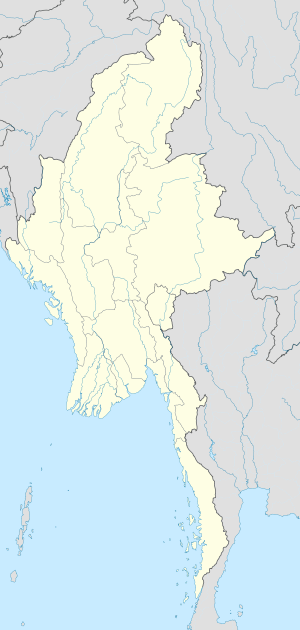Yetagun gas field
The Yetagon gas field is an offshore gas field in the Andaman Sea. Following the Yadana project, the US$700 million Yetagun ("Flag of victory") project was the second natural gas offshore project in Myanmar.[1][4]
| Yetagon gas field | |
|---|---|
 | |
| Country | Myanmar |
| Region | Andaman Sea |
| Location | Taninthayi offshore area[1] |
| Block | M-12, M-13 and M-14[1] |
| Offshore/onshore | offshore[1] |
| Coordinates | 13.0725°N 96.873611°E |
| Operator | Petronas[2] |
| Partners | Petronas (40.9%) PTT Exploration & Production (19.3%) Myanma Oil and Gas Enterprise (20.5%) Nippon Oil (19.3%)[2] |
| Field history | |
| Discovery | 1992[3] |
| Start of development | 1996/1997[3] |
| Start of production | May 2000[3] |
| Production | |
| Estimated gas in place | 3,200×109 cu ft (91×109 m3) |
Description
The Yetagun gas field contained a reserve estimated at 3.2 trillion cubic feet (91 billion cubic metres).[1] In 2000, the production started at 200 million cubic feet per day (5.7 million cubic metres per day) and could go up to 300 million cubic feet per day (8.5 million cubic metres per day).[1] It travels through a 169-mile (272 km), 24-inch (610 mm) diameter pipeline to Thailand.[1] About 140 miles (230 km) of the pipelines is undersea, and the rest of it is onshore, where it links with the Yadana pipeline.[5] Also, Yetagun could produce eight to nine thousand barrels of gas condensate per day.[1]
History
The Yetagun gas field was a joint venture between Texaco (50%), Premier Oil (30%), and Nippon Oil (20%).[5] After Texaco withdrew in 1997 and Premier Oil withdrew in 2002, Petronas became the operator.[5]
In 2008, the Yetagun gas pipeline had a problem with leaking, causing a loss of 400-500 million cubic feet per day (cfd) to Thailand.[6]
In 2011, a helicopter hired by Petronas to work at Yetagun crashed in the Andaman Sea, killing 3 people while 11 people survived.[7]
Controversy
Some controversy exists regarding the Yetagun (and Yadana) pipeline since some of the profits go to the Burmese government which has a poor human rights record.[8] Also, the main export pipeline runs through an area associated with the Mon and Karen ethnic minorities.[8] There have also been reports of forced labor to build a railway to the pipeline terminus.[8] Furthermore, some are concerned about the environmental impact the pipelines will have on forests.[8][9]
Though Texaco sold its shares for ostensibly commercial reasons, some believe that the US government’s sanctions on investments in Burma contributed to their withdrawal.[8] Similarly in 2002, when Premier withdrew, activists claimed victory in a 10-year-long campaign against the company’s activity, whereas Premier insisted it pulled out due to commercial interests.[10]
See also
References
- Kin Wah Chin (2005). Southeast Asian affairs 2005. Institute of Southeast Asian Studies. p. 265. ISBN 978-981-230-306-6. Retrieved 3 March 2012.
- Kin Wah Chin (2005). Southeast Asian affairs 2005. Institute of Southeast Asian Studies. p. 286. ISBN 978-981-230-306-6. Retrieved 3 March 2012.
- Premier Oil (2000). "22 June - First Gas from Yetagon Field". Retrieved 2 March 2012.
- Ashley South (2003). Mon nationalism and civil war in Burma: the golden sheldrake. Psychology Press. p. 200. ISBN 978-0-7007-1609-8. Retrieved 3 March 2012.
- Sudhir Devare; Institute of Southeast Asian Studies (31 December 2008). A new energy frontier: the Bay of Bengal region. Institute of Southeast Asian Studies. p. 48. ISBN 978-981-230-781-1. Retrieved 3 March 2012.
- "Myanmar's Yetagun gas pipeline leaking - PTTEP". Reuters. 2 April 2008. Retrieved 3 March 2012.
- "3 Killed in Yetagun Copter Crash". The Irrawaddy. 11 July 2011. Retrieved 3 March 2012.
- Jem Bendell (1 December 2000). Terms for endearment: business, NGOs and sustainable development. Greenleaf Publishing. p. 59. ISBN 978-1-874719-29-8. Retrieved 3 March 2012.
- Bogumil Terminski, (2012), Oil-Induced Displacement and Resettlement. Social Propblem and Human Rights Issue, Working Paper, Simon Fraser University, Vancouver.
- "Protest-hit oil firm bows out of Burma". BBC News. 16 September 2002. Retrieved 3 March 2012.